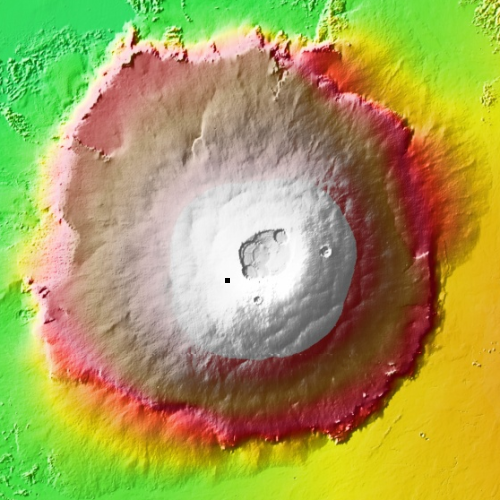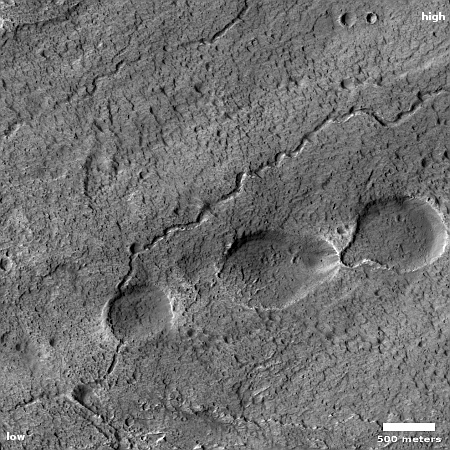Ancient flood lava on the upper slopes of the solar system’s largest volcano
Cool image time! The picture to the right, cropped, reduced, and sharpened to post here, was taken on July 13, 2023 by the high resolution camera on Mars Reconnaissance Orbiter (MRO).
In this one picture can be seen a glimpse of the entire history of the numerous lava eruptions that once dominated Mars when its giant volcanoes were active one to three billion years ago. The three aligned craterlike depressions likely signal the existence of a large lava tube below ground, placed there during an early large eruption, when the volcano was spewing out so much flood lava that such large tubes could form. The smaller meandering surface rills signal later eruptions that carried less flood lava and thus produced a smaller drainage features.
And finally, the rough and cracked appearance of the surface indicates the ancient age of those last eruptions, probably laid down about a billion years ago. Since then, the volcano has been dormant, and the frozen lava here has had time to erode, become roughened, and show signs of slowly wearing away.

The black dot on the overview map to the right marks the location, on the western upper flanks of Olympus Mons, the largest known volcano in the solar system. The caldera is only about 14 miles away, so because we are near the top of the volcano the surface lava at this spot is likely some of the last active lava spewed out. Though it is very old, it is also some of the youngest Olympus Mons’ lava.
Though Olympus Mons is more than twice as high as Mount Everest, the slopes on its flanks are extremely gentle. From high to low the descent here is about 700 feet, across a distance of about three miles. That is not a very steep grade, about 3%, and it continues unchanged at about that angle for many many miles.
One last caveat: The three aligned depressions might be indicating a vent from which lava also poured. Thus, some of the lava at this location might not have come from the volcano’s main caldera, but from an opening at this spot.
On Christmas Eve 1968 three Americans became the first humans to visit another world. What they did to celebrate was unexpected and profound, and will be remembered throughout all human history. Genesis: the Story of Apollo 8, Robert Zimmerman's classic history of humanity's first journey to another world, tells that story, and it is now available as both an ebook and an audiobook, both with a foreword by Valerie Anders and a new introduction by Robert Zimmerman.
The print edition can be purchased at Amazon or from any other book seller. If you want an autographed copy the price is $60 for the hardback and $45 for the paperback, plus $8 shipping for each. Go here for purchasing details. The ebook is available everywhere for $5.99 (before discount) at amazon, or direct from my ebook publisher, ebookit. If you buy it from ebookit you don't support the big tech companies and the author gets a bigger cut much sooner.
The audiobook is also available at all these vendors, and is also free with a 30-day trial membership to Audible.
"Not simply about one mission, [Genesis] is also the history of America's quest for the moon... Zimmerman has done a masterful job of tying disparate events together into a solid account of one of America's greatest human triumphs."--San Antonio Express-News
Cool image time! The picture to the right, cropped, reduced, and sharpened to post here, was taken on July 13, 2023 by the high resolution camera on Mars Reconnaissance Orbiter (MRO).
In this one picture can be seen a glimpse of the entire history of the numerous lava eruptions that once dominated Mars when its giant volcanoes were active one to three billion years ago. The three aligned craterlike depressions likely signal the existence of a large lava tube below ground, placed there during an early large eruption, when the volcano was spewing out so much flood lava that such large tubes could form. The smaller meandering surface rills signal later eruptions that carried less flood lava and thus produced a smaller drainage features.
And finally, the rough and cracked appearance of the surface indicates the ancient age of those last eruptions, probably laid down about a billion years ago. Since then, the volcano has been dormant, and the frozen lava here has had time to erode, become roughened, and show signs of slowly wearing away.

The black dot on the overview map to the right marks the location, on the western upper flanks of Olympus Mons, the largest known volcano in the solar system. The caldera is only about 14 miles away, so because we are near the top of the volcano the surface lava at this spot is likely some of the last active lava spewed out. Though it is very old, it is also some of the youngest Olympus Mons’ lava.
Though Olympus Mons is more than twice as high as Mount Everest, the slopes on its flanks are extremely gentle. From high to low the descent here is about 700 feet, across a distance of about three miles. That is not a very steep grade, about 3%, and it continues unchanged at about that angle for many many miles.
One last caveat: The three aligned depressions might be indicating a vent from which lava also poured. Thus, some of the lava at this location might not have come from the volcano’s main caldera, but from an opening at this spot.
On Christmas Eve 1968 three Americans became the first humans to visit another world. What they did to celebrate was unexpected and profound, and will be remembered throughout all human history. Genesis: the Story of Apollo 8, Robert Zimmerman's classic history of humanity's first journey to another world, tells that story, and it is now available as both an ebook and an audiobook, both with a foreword by Valerie Anders and a new introduction by Robert Zimmerman.
The print edition can be purchased at Amazon or from any other book seller. If you want an autographed copy the price is $60 for the hardback and $45 for the paperback, plus $8 shipping for each. Go here for purchasing details. The ebook is available everywhere for $5.99 (before discount) at amazon, or direct from my ebook publisher, ebookit. If you buy it from ebookit you don't support the big tech companies and the author gets a bigger cut much sooner.
The audiobook is also available at all these vendors, and is also free with a 30-day trial membership to Audible.
"Not simply about one mission, [Genesis] is also the history of America's quest for the moon... Zimmerman has done a masterful job of tying disparate events together into a solid account of one of America's greatest human triumphs."--San Antonio Express-News



The settling cracks along side the lava tube is evidence that this tube is very large.
A good measure of the slope is the “three pools” which are filled showing the Highwall on the right with the outflow on the left with the floor of the pool being level.
One of the cracks extended through the lower pool showing the volcano still settling. A dark smudge could be an out gassing vent? (there is bound to be many hollow cavities)
One item of note, the top of this volcano is above the Martian atmosphere… What we are seeing has been unaffected by Martian winds giving the lower half of the picture the appearance of lunar regolith. Impact craters big and small cover the surface.
Just came in from watching the annular eclipse, 93% covered in SLC. Wispy clouds parted just in time.
Spectacular as always.